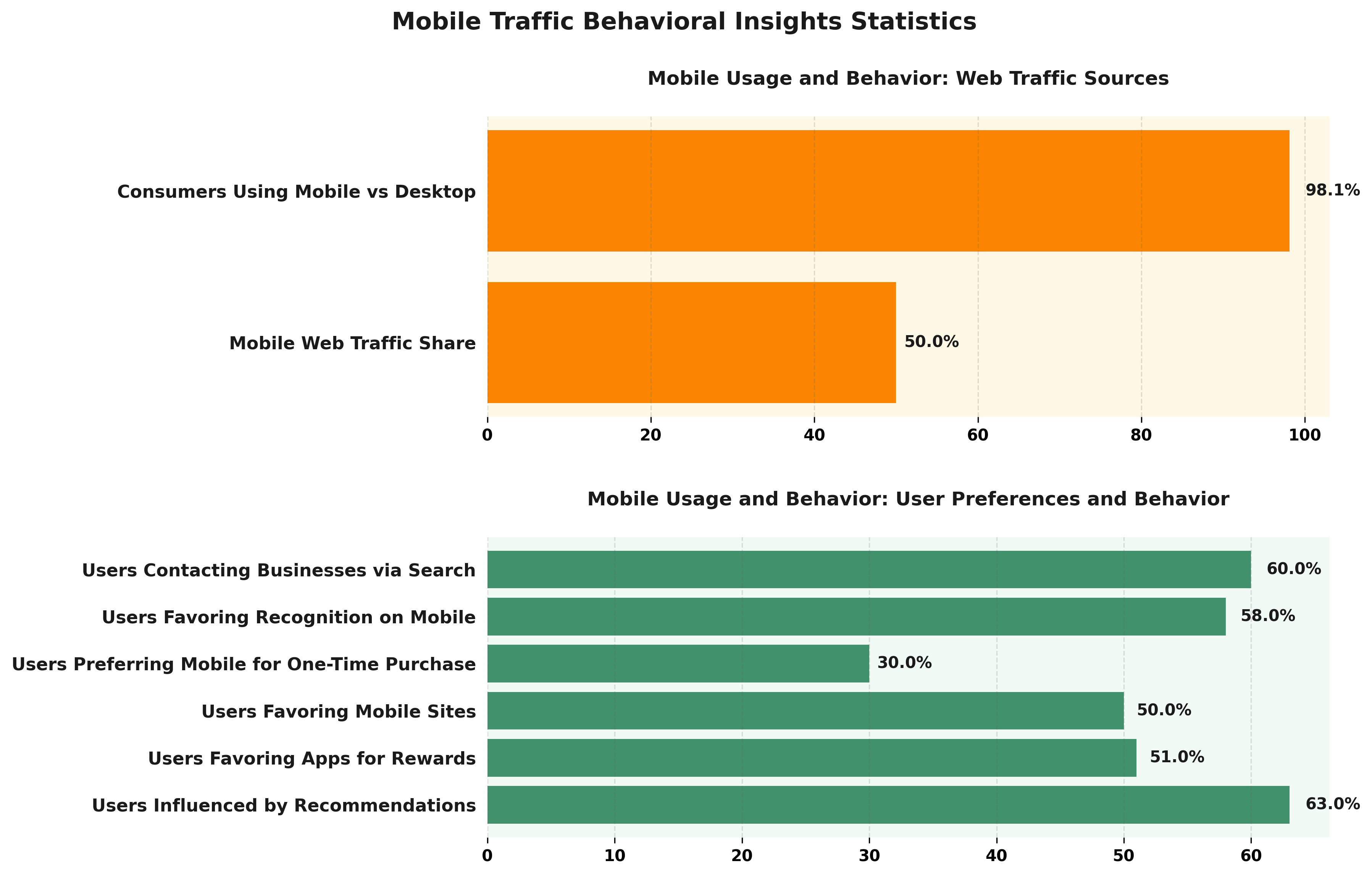In the current fast-paced digital landscape, comprehending mobile traffic data is essential for marketers seeking to engage effectively with their target audiences and understand customer engagement. This article examines the manner in which mobile traffic data offers valuable insights into consumer behavior, facilitating the development of personalized campaigns that enhance engagement. Readers will acquire knowledge on how to collect and analyze this data, identifying critical insights such as device preferences, location-based interactions, and behavioral patterns. Additionally, the article will elucidate how to leverage these insights to refine marketing strategies, personalize experiences, and achieve improved campaign outcomes.
Key Takeaways: Mobile traffic data provides valuable insights on consumer behavior patterns, enabling marketers to create personalized campaigns that drive better engagement and understand customer preferences.Gathering and analyzing mobile traffic data can be done through mobile analytics tools, leveraging app and website data, partnering with mobile data providers, and using cloud communication solutions.Insights gained from mobile traffic data include device usage, location-based interactions, and user engagement, which can be used to optimize targeting, messaging, timing, and measurement for successful marketing campaigns.
Why is Mobile Traffic Data Important for Marketers?
Mobile traffic data is crucial for marketers as it provides deep insights into customer engagement and behavior-based engagement that go beyond traditional segmentation and customer demographics.
By understanding how, when, and where consumers interact with brands through their smartphones, marketers can tailor their strategies to meet customer needs and preferences, ultimately enhancing the effectiveness of their marketing campaigns.
In an era where competition is fierce, leveraging mobile traffic data enables businesses to optimize their marketing strategies, boost engagement, and better target consumer behavior for business growth.
Understanding Consumer Behavior Patterns
Understanding consumer behavior patterns is essential for marketers looking to tailor their communication strategies effectively, as it allows them to develop targeted campaigns that resonate with their audience and drive engagement. Behavioral insights into how individuals interact during their shopping experience can illuminate key preferences and pain points that inform marketing initiatives.
Several factors significantly influence these consumer behaviors, including:
- Shopping Cart Usage: The way consumers interact with shopping carts, from abandonment rates to adding items, reveals how they prioritize products and make purchasing decisions.
- Micro-Moments: These brief instances where consumers seek information or make decisions can dramatically shift their purchasing journey, emphasizing the need for brands to be present at critical touchpoints or micro-moments.
- Mapping Customer Journeys: Understanding the sequence of interactions customers have with a brand through customer journey mapping allows marketers to identify improvement areas, enhancing overall satisfaction and loyalty.
By integrating these components into their strategies, businesses can better align their offerings with customer preferences and needs, ultimately driving more effective marketing outcomes.
Mobile Traffic Behavioral Insights Statistics

The Mobile Traffic Behavioral Insights Statistics provide key insights into how consumers engage with mobile platforms compared to traditional desktop use, as well as their preferences and behaviors influenced by mobile technology. This data is crucial for businesses aiming to optimize their digital strategies to meet consumer needs.
Mobile Usage and Behavior shows that mobile devices now account for 50% of web traffic, underscoring the growing importance of mobile-friendly websites and applications. With a striking 98.1% of consumers using mobile devices compared to desktops, this shift towards mobile-first engagement is evident. Businesses must ensure seamless mobile experiences to capture and retain consumer attention.
- User Preferences and Behavior:
- 63% of users are influenced by recommendations on mobile platforms, highlighting the power of social proof and peer influence. Leveraging customer reviews and testimonials can enhance brand trust and conversion rates.
- 51% of users favor apps for rewards, emphasizing the effectiveness of loyalty programs and exclusive app-based incentives to boost engagement and repeat purchases.
- The data shows a balanced preference, with 50% favoring mobile sites and another 30% preferring mobile for one-time purchases, suggesting that while apps are popular, the convenience of mobile sites remains important for certain transactions.
- 58% of users favor recognition on mobile, indicating the value of personalized experiences. Tailoring content and offers based on user behavior and preferences can significantly enhance user satisfaction and loyalty.
- With 60% of users contacting businesses via search, optimizing for mobile search and ensuring visibility in local search results is essential for businesses looking to attract and convert mobile users.
These statistics demonstrate a clear trend towards mobile dominance in consumer behavior. Companies that adapt to this trend by optimizing their mobile presence, offering personalized and rewarding experiences, and ensuring easy searchability will be well-positioned to succeed in the increasingly mobile-centric market. Additionally, leveraging AI technologies can further enhance personalization and targeting.
Personalizing Campaigns for Better Engagement
Personalizing marketing campaigns using targeted content is a proven method to enhance customer engagement and satisfaction. This approach not only boosts sales but also fosters a deeper connection between brands and their customers, creating an environment where each individual feels valued and understood. By leveraging customer insights and preferences, businesses can curate their offerings in a way that resonates with each unique segment of their audience, ultimately leading to improved loyalty and trust. Understanding customer behavior is at the heart of these personalized marketing strategies, allowing brands to tailor their messages effectively.
Employing behavioral data to create tailored experiences is fundamental for success in today’s competitive landscape. For instance, companies can track users’ online interactions and purchasing habits to segment their audience into distinct groups. With this invaluable information, businesses can craft personalized content that addresses specific needs and interests.
- Loyalty programs are another impactful method to enhance personalization. By rewarding customers based on their preferences and purchase history, businesses not only boost retention but also encourage repeat purchases.
- Brands like Amazon exemplify successful personalized marketing by suggesting products based on past behavior, which significantly increases conversion rates.
Ultimately, these techniques streamline communication and foster long-lasting relationships, yielding a loyal customer base that drives sustained growth.
Improving Relevancy and Impact of Ads
Improving the relevancy and impact of ads is crucial for maximizing ROI in today’s competitive marketing landscape, as businesses strive to capture consumer attention amidst a daily barrage of information, enabling them to foster genuine connections with their audience and influence purchasing decisions effectively.
One effective strategy for enhancing ad relevancy is the utilization of real-time analytics, which enables marketers to adjust their campaigns dynamically based on the immediate behavior and preferences of potential customers. By leveraging automated interactions, businesses can tailor their messaging to specific demographics, ensuring that communications resonate with the right audiences at the right moments.
For instance, Apple has mastered personalized marketing through its targeted email campaigns, which recommend products based on user preferences and past purchases. Similarly, Google employs sophisticated algorithms to analyze user search histories, serving tailored ads that significantly increase engagement levels.
- Emphasizing customer feedback loops and social listening tools to understand real-time sentiment can further refine targeting.
- Incorporating A/B testing allows brands to explore different messaging approaches to see what resonates most effectively with their audience.
By employing these strategies, companies can not only enhance the performance of their advertisements but also build stronger customer relationships.
How to Gather and Analyze Mobile Traffic Data and Customer Insights

Gathering and analyzing mobile traffic data involves utilizing various tools and strategies that can effectively track user interactions, behaviors, and customer interactions across multiple platforms.
Using Mobile Analytics Tools
Mobile analytics tools provide critical insights into customer behavior and engagement in real-time.
These sophisticated platforms streamline the process of tracking user interactions, allowing marketers to uncover trends and patterns that may go unnoticed otherwise. By leveraging powerful analytics, businesses can identify which features are most engaging and understand the paths users take through their applications.
- Real-time data enables adjustments based on immediate feedback, ensuring that marketing strategies remain relevant and effective.
- Understanding user preferences and habits facilitates personalized marketing efforts, leading to improved customer loyalty.
Ultimately, harnessing these tools can lead to data-driven decisions that significantly enhance customer experiences and drive growth.
Leveraging Data from Mobile Apps and Websites
Leveraging data from mobile apps and websites is essential for a comprehensive understanding of consumer behavior.
By tapping into various touchpoints, organizations can gather invaluable insights that reflect not only how customers interact with a brand but also their preferences and overall journey. These insights form a crucial part of the strategic planning process, enabling businesses to make informed decisions that enhance user experience and streamline service delivery. Integrating cloud communication facilitates seamless data collection and analysis; this creates a cohesive framework that connects disparate data sources, ultimately revealing a more nuanced picture of customer interactions.
- Identifying patterns in browsing habits.
- Understanding time spent on different features.
- Tracking user engagement across platforms.
Such comprehensive data analysis equips businesses to refine their marketing strategies, tailor content specifically to audience interests, and foster stronger customer relationships based on informed insights.
Partnering with Mobile Data Providers
Partnering with mobile data providers can significantly enhance a marketer’s ability to collect and analyze consumer behavior data.
Collaborating with mobile data providers opens up a plethora of opportunities for refining marketing strategies, as these partnerships grant immediate access to comprehensive datasets that encapsulate consumer habits and trends. By leveraging advanced analytics and integrated AI technologies, marketers can draw deeper insights and tailor their campaigns with unmatched precision.
For instance, companies like Starbucks have successfully utilized partnerships with mobile data providers to target promotions effectively based on customer location and purchasing habits.
- Enhanced targeting through real-time data insights
- Improved customer engagement with personalized offers
- Streamlined campaign optimization using AI tools
The ability to adapt strategies rapidly, based on dynamic consumer behavior analysis, enables marketers to stay ahead in a competitive landscape.
What Insights Can Be Gained from Mobile Traffic Data?

Mobile traffic data yields invaluable insights into various aspects of consumer behavior, including device usage, location-based interactions, and user engagement metrics.
Device Usage and Preferences
Understanding device usage and preferences among smartphone users is critical for tailoring marketing strategies and ensuring effective communication strategy across varied devices.
As technology evolves, the shift in consumer behavior has become increasingly pronounced, making it essential for marketers to adapt accordingly. With the rise of mobile phones dominating everyday life, businesses must recognize the importance of optimizing their campaigns for different platforms.
Aligning marketing initiatives with the unique habits of smartphone users allows for more effective outreach.
- For instance, studies show that users are more likely to engage with brands that utilize location-based services.
- Personalizing content based on user preferences fosters a deeper connection with the audience.
- Incorporating visually appealing elements tailored for mobile viewing can enhance user experience and drive conversions.
By staying attuned to these trends, companies can make more informed decisions, ensuring their marketing efforts resonate with the target audience.
Location-based Interactions
Location-based interactions offer powerful insights into consumer behavior and preferences, enabling marketers to create more effective campaigns that resonate on a personal level with their target audiences.
By tapping into the wealth of data generated by consumers’ geographical movements, marketers can uncover trends and preferences that enhance their outreach. For instance, a popular coffee chain utilized location-based data to identify peak foot traffic times near their stores. By analyzing this information, they tailored their promotions and advertisements to coincide with these high-traffic periods, resulting in a significant increase in sales.
Another notable example is a fashion retailer that deployed geofencing technology to send personalized discounts to customers’ smartphones as they entered a shopping district. This strategic approach increased both footfall and conversion rates, demonstrating how localized marketing efforts can yield measurable results.
- Opportunity for timely, relevant engagement with potential customers
- Ability to enhance customer journey by delivering location-specific content
- Increased customer loyalty through personalized experiences
Time and Frequency of Interactions
Analyzing the time and frequency of interactions can provide critical insights into consumer engagement patterns.
Understanding when customers engage with a brand is crucial for marketers aiming to refine their strategies. By pinpointing specific times that yield higher interaction rates, marketers can tailor their campaigns to reach audiences when they are most receptive.
Tracking the frequency of these interactions allows for a nuanced approach to customer journey mapping, enabling businesses to identify touchpoints that require reinforcement or adjustment, similar to how Salesforce enhances customer support and engagement.
- This tailored approach not only enhances engagement but also fosters a stronger relationship with consumers.
- Using analytics to segment audiences based on interaction timing can help in crafting personalized messaging.
- Ultimately, this meticulous analysis creates a more streamlined and effective marketing strategy.
Implementing these insights can result in a more engaged customer base and, consequently, improved campaign outcomes.
User Engagement and Conversion Rates

User engagement metrics and conversion rates are key indicators of the effectiveness of marketing strategies.
To truly understand how these metrics reflect consumer behavior, one must delve deeper into the array of data available. By analyzing how users interact with content—such as time spent on pages, click-through rates, and social shares—marketing professionals can pinpoint areas needing improvement. Examining conversion rates provides insight into the effectiveness of messaging and offers.
- Engagement Depth: Look beyond surface-level interactions to gauge true interest.
- Segment Analysis: Categorizing users based on tendencies can reveal specific preferences.
- A/B Testing: Experimenting with different strategies can illuminate paths to optimal conversion.
Integrating behavioral data insights allows teams to refine their marketing strategies judiciously, ensuring efforts are not only targeted but also resonate deeply with the audience, leading to better engagement and conversion results.
How Can Marketers Use Mobile Traffic Data to Improve Campaigns?
Marketers can significantly enhance their campaigns by utilizing mobile traffic data to target the right audience, create personalized ads, and measure success effectively, all while maintaining ethical privacy practices.
Targeting the Right Audience
Targeting the right audience is paramount for any successful marketing strategy, especially when utilizing mobile traffic data, as it allows marketers to reach individuals who are most likely to engage with their products or services effectively.
By leveraging mobile analytics and real-time data, businesses can analyze user behavior, preferences, and trends to tailor their messaging. For instance, a retail app might use insights from location-based analytics to send targeted promotions to users when they are near a store. This not only heightens engagement but also increases foot traffic.
Behavioral segmentation can be particularly effective; understanding that a user frequently searches for fitness-related products allows for personalized advertisements that resonate with their interests.
- Implementing A/B testing can further refine strategies, gauging which messages yield better responses.
- Integrating push notifications based on user activity keeps brands at the forefront of customer awareness.
The ultimate goal remains clear: to create a connection that resonates and encourages action.
Creating Personalized and Relevant Ads
Creating personalized and relevant ads based on consumer behavior can drastically increase engagement rates.
To effectively design advertisements that connect with the target audience, one must delve into the nuances of mobile traffic data. By analyzing insights such as user interactions and preferences, marketers can create tailored messages that resonate on a personal level. Here are some key strategies to consider:
- Understand the Audience: Utilize demographic information and behavioral patterns to segment the audience clearly.
- Leverage Data Analytics: Examine real-time analytics to identify trends and preferences that can shape ad content.
- Create Engaging Content: Personalization doesn’t just mean inserting a name; it includes crafting relatable narratives that align with interests and needs.
Testing different ad formats and channels can further optimize reach and effectiveness. When crafted thoughtfully, these personalized ads not only capture attention but also foster a deeper connection with consumers, driving both engagement and loyalty.
Optimizing Campaign Timing and Frequency
Optimizing the timing and frequency of marketing campaigns is essential to maximizing their effectiveness.
When considering how to achieve this goal, marketers should delve into various strategies aimed at analyzing interaction data effectively. By examining consumer behavior patterns, one can uncover trends that suggest when potential customers are most receptive to promotional content. Utilizing tools like analytics software can help identify peak engagement times based on historical data. Segmenting the audience allows for tailored campaigns that hit relevant demographics at their optimal moments.
In this context, it is crucial to monitor key metrics such as open rates and click-through rates, as these indicators can reveal the most favorable windows for ad delivery. In addition, leveraging A/B testing helps refine messaging and timing strategies:
- Assessing previous campaign outcomes
- Identifying high-engagement time slots
- Adjusting frequency based on consumer response
By employing these methods, marketers can enhance their chances of reaching consumers when they’re more likely to convert, thereby boosting overall campaign performance.Understanding these timing dynamics is critical for achieving advertising success.
Measuring and Adjusting for Success
Measuring and adjusting marketing campaigns based on data-driven insights is crucial for ongoing success.
In today’s digital landscape, organizations must prioritize effective evaluation of their initiatives to ensure optimal engagement and return on investment. Various methods can be employed to assess performance, prominently featuring the establishment of key performance indicators (KPIs) tailored to specific objectives. These metrics might encompass conversion rates, customer acquisition costs, and engagement levels across channels.
By systematically analyzing customer satisfaction metrics and behavior patterns, companies can refine their strategies to better resonate with target audiences.
- Regularly review KPI data to identify trends.
- Adapt marketing strategies in response to real-time feedback.
- Utilize A/B testing to determine content efficacy.
Ultimately, it’s about fostering an ongoing cycle of assessment, adjustment, and improvement that leads to sustained success in a competitive market, often leveraging platforms like Communication-Platform-as-a-Service for enhanced results.
Conclusion: Harnessing the Power of Mobile Traffic Data for Marketing Success
Harnessing the power of mobile traffic data is integral to achieving marketing success in today’s digital landscape, enabling businesses to create personalized experiences that resonate with consumers and foster meaningful relationships.
In an era where attention spans are rapidly shrinking, understanding the nuances of how consumers interact with mobile platforms becomes more essential than ever. Businesses can utilize this invaluable data to decode patterns, preferences, and behaviors, ultimately leading to more profound insights into their target audience.
By analyzing trends in mobile traffic data, marketers can tailor their strategies to align with consumer needs, resulting in higher engagement rates and improved campaign effectiveness. This data not only drives better decisions but also enhances resource allocation across advertising platforms, ensuring that marketing efforts yield optimal results.
- Identify key consumer behavior patterns.
- Optimize marketing strategies based on real-time insights.
- Strengthen customer relationships through personalized content.
To remain competitive, marketers must seize the opportunity that mobile traffic data presents, transforming insights into actionable strategies that foster growth and establish lasting consumer connections.
Frequently Asked Questions
What is Beyond Demographics: Uncovering Behavioral Insights from Mobile Traffic?
Beyond Demographics: Uncovering Behavioral Insights from Mobile Traffic is a process of analyzing mobile traffic data to gain insights into consumer behavior, such as how, when, and where they interact with brands. This allows marketers to create personalized campaigns that resonate on a deeper level and deliver more relevant and impactful ads.
How can analyzing behavioral data from mobile traffic benefit marketers?
By analyzing behavioral data from mobile traffic, marketers can gain a deeper understanding of their target audience and create more effective marketing campaigns. This can result in improved engagement, higher conversions, and a better return on investment.
What type of information can be uncovered through behavioral data analysis of mobile traffic?
Behavioral data analysis of mobile traffic can reveal information such as which mobile devices are most commonly used, the times and locations where consumers are most active, and which types of content or ads are most engaging, assisting in the development of effective learning guides for marketing strategies.
Is it possible to create personalized campaigns using behavioral insights from mobile traffic?
Yes, by utilizing behavioral insights from mobile traffic, marketers can create personalized campaigns that resonate with their target audience on a deeper level. This can include targeting specific devices, times, and locations, as well as tailoring the content or messaging to align with consumer behavior patterns.
How does analyzing mobile traffic data differ from traditional demographic targeting?
Traditional demographic targeting focuses solely on characteristics such as age, gender, and income. Analyzing mobile traffic data goes beyond these basic demographics and provides a more comprehensive understanding of consumer behavior and preferences.
Are there any potential challenges to consider when using behavioral data from mobile traffic?
While analyzing behavioral data from mobile traffic can provide valuable insights, it is important for marketers to ensure they are using reliable and accurate data. They should also be mindful of consumer privacy and ensure they are using data in an ethical and responsible manner.







